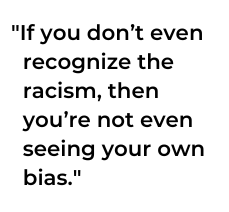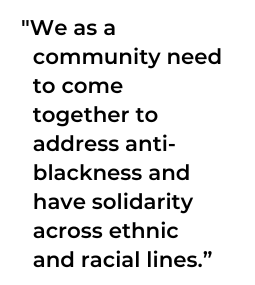

There was a time when Daisy Han would
never dream of using her real name. It was too weird, too hard to
pronounce, and none of the kids she grew up with in the San
Francisco Bay Area had such exotic first names.
“My Korean name is Heyjin,” she says. “And I would feel shame when
my parents or family would call me that in public.”
Han had a good reason. Even though she was the first American-born
member of her family, she always felt like an outsider here. It was
a feeling, she says, that started as far back as kindergarten, when
her mother dropped her off for her first day of school.
“It was a traumatic transition,” says Han, who was raised by her
grandparents and spoke very little English at the time. ”I still
remember to this day crying so hard that my teeth were chattering,
and my brain felt like it was rattling in my skull.”
To make matters worse, Han says that as she watched her mother
staring back at her from outside the classroom window and sobbing
even harder, the teacher did something unimaginable. She crouched
down and said, “Don’t worry my little China doll,” and started
making silly faces, including pulling her eyes into slants, in an
effort to make the five-year-old laugh.
 Looking
back, Han says, the experience taught her about the dangers of
racism in American schools and how it harmed children of color like
herself.
Looking
back, Han says, the experience taught her about the dangers of
racism in American schools and how it harmed children of color like
herself.
“In that moment, I learned I had to be as white as possible,” she
says. “I had to sacrifice a lot of my ethnic identity, a lot of my
familial relationship, and my native language in order to be
successful. And I resolved to create a learning environment where
children could bring their full selves.”
And Han did just that. In 2017, after a 14-year career as a teacher
and principal, she launched Embracing Equity, a social change
organization designed to revamp K-12 education by training teachers
and administrators how to create and reinforce inclusive teaching in
the classroom--first by identifying and analyzing racist behaviors
and then by unlearning and avoiding them.
The completely online curriculum, created by Han and a team of
fellow students from the Harvard Graduate School of Education,
started as a 10-week program involving direct coaching with
individual teachers and has evolved into customized levels of
training with school districts, school leaders, and educational
organizations based on “what they need and where they want to go.”
The leaders of those institutions can now sign up for a year-long
residency program that will teach them how to identify inequity,
build empathy, enact change, and hold staff accountable through
“equity audits,” which include data collection and reporting back on
goals and achievements. This ensures that daily conversations about
racism are also “built into our teaching” and not just during Black
History Month or when a tragedy like the murder of George Floyd
takes place.
Now in its fifth year, the Austin, TX-based nonprofit has reached
more than 2,000 educators in 47 states, in addition to Washington,
D.C., Puerto Rico, and 19 countries, which is impressive considering
Embracing Equity’s reach is mainly by word-of-mouth, and that the
organization operates with a staff of only 20, mostly women of
color, who are trained in-house in ways to help educators “dismantle
systemic oppression” in schools, both at the individual and
institutional levels.
Han hopes that by 2030 Embracing Equity will serve one million
children through its programming and that anti-racist training will
be mandatory in the national board certification process for
teachers. Although a growing number of states explicitly advise
teachers to take professional development courses in cultural
competency, Han says only two--Connecticut and Maryland--require
such training as part of teacher certification. Han hopes that
arming teachers with these tools also will help elevate the
profession and bring along the respect it deserves.
 Born in San Jose, California, Han grew up in a
progressive, white neighborhood and was drawn to justice and
fairness from a young age. “Witnessing my parents struggle as
immigrants made me incredibly sensitive and observant of the ways in
which systemic racism impacts our daily lives.”
Born in San Jose, California, Han grew up in a
progressive, white neighborhood and was drawn to justice and
fairness from a young age. “Witnessing my parents struggle as
immigrants made me incredibly sensitive and observant of the ways in
which systemic racism impacts our daily lives.”
Yet, it wasn’t until Han signed up for a freshman ethnic studies
class at the University of California, Berkeley, that she finally
experienced a classroom that celebrated ethnic differences and
taught students to be proud of them. That’s when she decided to
become a teacher.
“I realized the illness of racism that I’d been coping with my whole
life was not a personal failure,” she says. “Instead, society was
sick. We’re held to the standards that make white characteristics
superior and the characteristics of people of the global majority
inferior.”
Han abandoned her pre-law studies, majored in ethnic studies at
Berkeley, and went on to study Montessori education at Saint Mary’s
College of California. During the years she spent teaching in
California and Hawaii, she realized that educators like herself
“needed and deserved better training” in ways that nurtured
children’s differences and helped them reach their full potential.
But she couldn’t do it alone.
Han returned for a second master’s degree in 2017--this time at the
Harvard Graduate School of Education--to focus on equity in the
classroom. From there, she shifted to the nonprofit world to work on
education reform, joining the Wildflower Foundation, which
supports a network of Montessori schools. While there, Han launched
a free online pilot program that eventually led to Embracing Equity.
“I wrote a blog post asking if there were folks who wanted to learn
more about white supremacy culture, how it shows up in our
classroom, how it shows up in the way we teach, and how we can
actually be a part of the solution in creating a more fair and
equitable world,” she says.
Han had hoped for 30 sign-ups. Instead, she got 300.
“The momentum was there,” she says, explaining that the overwhelming
response coincided with the election of Donald Trump, whose long
history of racism followed him to the White House. “I was hearing
from people all around the country that we needed this. Teachers
were saying, ‘Wow, I’ve done a lot of harm in the field, and I
didn’t even realize it.”
 While many factors contribute to the nation’s
achievement gap, teachers with implicit biases--for example, those
who discipline and expel Black students more than their white
counterparts or who make kids like Han feel like perpetual
foreigners--rob children of educational achievement. “I had to learn
coping mechanisms to help me survive and be resilient and successful
through school,” says Han, explaining that the microaggressions she
experienced were like “1,000 paper cuts a day.” In fact,
discrimination due to ethnicity, nationality, language ability,
accent, or immigration status leads to lower student academic
motivation, negative attitudes about school, increased high school
dropout rates, and even post-traumatic stress disorder, says a 2015
study by the Migration Policy Institute,
a nonpartisan organization that seeks to improve immigration and
integration.
While many factors contribute to the nation’s
achievement gap, teachers with implicit biases--for example, those
who discipline and expel Black students more than their white
counterparts or who make kids like Han feel like perpetual
foreigners--rob children of educational achievement. “I had to learn
coping mechanisms to help me survive and be resilient and successful
through school,” says Han, explaining that the microaggressions she
experienced were like “1,000 paper cuts a day.” In fact,
discrimination due to ethnicity, nationality, language ability,
accent, or immigration status leads to lower student academic
motivation, negative attitudes about school, increased high school
dropout rates, and even post-traumatic stress disorder, says a 2015
study by the Migration Policy Institute,
a nonpartisan organization that seeks to improve immigration and
integration.
The need to train teachers in race equity and inclusion is more
urgent now than ever, Han says, given the nation’s rapidly shifting
demographics. White students nationwide comprised 22.6 million in
2020, compared to 26.6 million kids who identified as Black,
Hispanic, Asian, Native American, and/or two or more races,
according to the National Center
for Education Statistics, the research arm of the U.S. Department of Education.
“There are more students of color now than there are white students,
yet over 80 percent of our K through 12 teachers are white,” Han
says, explaining that this disproportionate ratio has led to a lot
of tensions that are equivalent to educational “malpractice.”
“We operate on the premise that we live in a racist society, so
inevitably we’ve absorbed these racist messages.” Han says. “If you
don’t even recognize the racism, then you’re not even seeing your
own bias. So if you don’t accept that premise, then Embracing Equity
is not for you.”
The organization’s in-your-face approach has already made an impact.
Close to 90 percent of participants--from newbies to 25-year
veterans--say they’re better equipped to talk about their role “in
perpetuating or resisting systemic racism” and all participants in
the leadership residency report implementing what they’ve learned
within three months, Han says. An overwhelming majority also say the
course has transformed them and that they’re more prepared to combat
anti-racist practices because they see the world through a more
critical lens.
Program participant Nicole H., describes Embracing Equity as a space
to “learn, unlearn, grow, heal, and develop the tools needed to…
uproot and dismantle white supremacy.”
Still, Han understands this work requires patience, understanding,
and forgiveness--and that it’s a lifelong journey of learning and
unlearning.
“Our programming is very much focused on internal healing,” she
says, explaining that educators must first recognize their own
biases and racist behaviors in order to effect change. “There’s a
lot of fear built up around racism, [so] it’s recognizing that you
can break these patterns and develop news skills. We need to accept
that we’re human, and we make mistakes. Mistakes are a part of
learning, and the only way to get better is to confront them.”
And now Han’s making sure that history doesn’t repeat itself,
especially when it comes to her own child, who’s about to enter
preschool.
“It’s full circle now because I have a toddler,” she says. “I’m not
only dealing with the fear of her contracting COVID, I’m also
navigating so much of my own fear and anxiety about the anti-Asian
racism she might have to confront.”
That’s why she’s building an Embracing Equity lab school in Dripping
Springs, TX, in a location she chose as an “act of defiance” against
the restrictive critical race theory legislation that went into
effect in her state last year.
With an estimated startup cost of $300,000, the Montessori preschool
will initially launch as a full, Spanish-immersion program with one
classroom housing 25 students, ages two to six. It will be staffed
with three master’s-level teachers who’ve gone through Embracing
Equity’s anti-racism training.
As a woman of color heading a social justice organization, Han says
she wants other Asians to see that they can be part of the solution.
“We as a community need to come together to address anti-blackness
and have solidarity across ethnic and racial lines,” she says.
And what about her Korean name, Heyjin? She now proudly includes it
in her bio, both in English and Hangul.
The US Mental Health Hotline Network Is Expanding, but
Rural Areas Still Face Care Shortages
by Christina Saint Louis
API
Teachers in the US School System
Peep
This: Must-try Eye Products That Won't Break the Bank
by Heidi Forbes
How to Report Hate Crimes Against AAPIs
Who, What, Where and How: AAPI Organizations
Learn More: What Others Are Saying